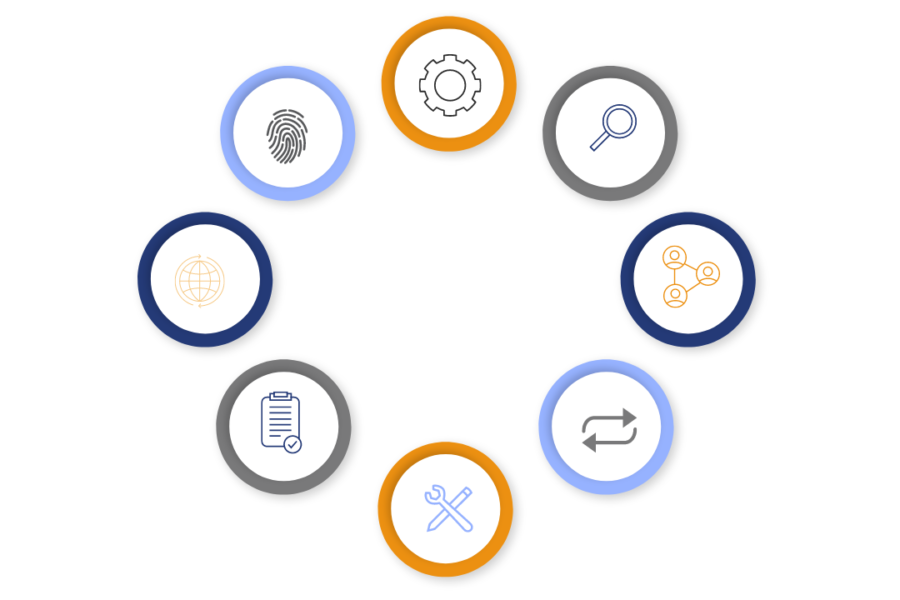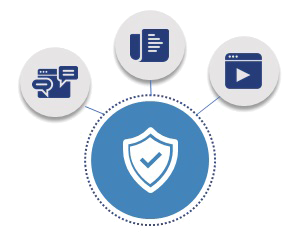Optimizing Your IAM Processes to Meet Organizational Needs
Written August 3, 2022

One of the most important lessons learned from the SolarWinds attack is that identity infrastructure is a target. Organizations must recognize this pattern so that identity verification is implemented appropriately.
Out-of-date identity and access management (IAM) solutions and inconsistent approaches to identity verification leave holes and vulnerabilities in an organization's attack surface. These are typically to blame for the common identity-related security issues and challenges that organizations face.
Organizations with identity verification requirements have historically employed various technologies to confirm user identity, review identification, and support papers, authenticate them each time, ensure they are not on any watchlists, among many more. However, because it fails to effectively detect cybercrime and thoroughly verify user identity, this strategy is expensive, difficult, and increases security threats.
Here are 5 Critical Strategies for Optimizing Your IAM Processes
1. Look Beyond the Traditional Network Perimeter
Security executives must reconsider their identity security strategies and tackle online identity assurance holistically by unifying identity verification services whenever it is feasible to battle today's rising threats. For instance, there are now unified platforms that use a single application programming interface (API) layer to assess a person's risk, their devices, IDs, and their facial biometrics.
With contemporary, end-to-end identity verification technology, it is less likely to have identity and IAM system vulnerabilities that hackers can use to access confidential internal data. Because of this, many security-focused firms are moving toward a modern, single, all-encompassing identity verification solution that unifies features ranging from user identity confirmation to compliance maintenance.
2. Replace Legacy IAM Solutions
Contrary to popular belief, layering more security measures on top of one another won't improve your company's security. Additionally, maintaining home-grown and outdated IAM solutions may be expensive and insufficient to handle modern identity risks. Finally, overusing IAM tools may result in integration problems that let more attackers bypass your security mechanisms in place such as perimeter VPN’s, gateway portals, etc .
It is important to regularly assess the Review the identity and access management systems your company employs to ensure that your IAM strategy is operating at its peak efficiency and your business needs are being met. Through an assessment you should examine the level of protection for you and your staff and consider updating or removing legacy solutions if they no longer support your needs.
3. Review and Optimize Existing Identity and Access Management Workflows
An identity and access management workflow are any sequence of actions your company performs to manage identities throughout your network. Onboarding (the process of adding new identities), access provisioning (the process of changing granting access to identities), and terminating identities are some examples of these operations (self-explanatory but vital).
Your company must determine how they define optimization in terms of identity and access management to determine how to best optimize your IAM procedures. Does the process at your company need to be more accurate and efficient? In that situation, automating your workflows might be the best option. Do you want to reduce the cost of IT cybersecurity so that your company can put more money into other areas of digital security? Limiting the automated processes your team uses could help to reduce some of the complexity and expenses associated with your IAM framework. Consult your IT cybersecurity team, evaluate what they can manage manually, and ask your solution provider what they can do to make the workflows more efficient.
4. Understand the Levels of Risk for Each Identity
Before you create an account for that employee or non-employee, be aware of the identified risks. So, suppose you have an identity that poses a high risk. In that case, you can tighten the controls surrounding it by providing more thorough auditing and reporting, restricting access, and disabling download functionality. When the risk is evaluated at the outset, subsequent decisions can be made based on that initial risk rating. However, the existing procedure involves creating many generic identities and thinking about the risk later, which jeopardizes the company's security.
5. Continually Educate and Inform Employees
Your IAM solution is only as robust as your workforce, which is your main point of vulnerability. Your attempts to maximize will be in vain if they treat their credentials carelessly, apathetically, or poorly.
To maximize your IAM, it is crucial to train your staff to spot phishing campaigns, create secure passwords, and implement 2-factor or multifactor authentication. Getting your staff interested in data protection is even more important. This can be achieved by incorporating identity and access management best practices into routine employee evaluations or rewarding good digital hygiene.
On your end, be mindful to avoid overcomplicating the experience to the point where it alienates staff. Even the best training in a field won't help if the rules are difficult to understand or annoying to adhere to. To determine where your company's identity and access control policies are contributing to unwarranted stress, poll your staff.
Challenges to Optimizing Identity Access Management
For businesses, managing digital identities may be extremely difficult. Due to the hundreds or thousands of identities that need to be verified and secured, including humans (workers, customers), machines (bots, devices), and application identities, many organizations struggle with identity sprawl. The degree of technical debt and security baggage associated with traditional solutions can also negatively affect an organization's readiness to make significant changes to its identity management strategy. The evil guys benefit from this apathy or attitude of "leave it as it's too complicated," though.
For security teams, taking risky actions and making significant decisions on issues where the risk may not be obvious to the board or the executive team is always a challenge. However, security teams must speak up, find their voice, and assist their organizations in understanding the risks associated with identity management in achieving their corporate objectives. Being still is never an option in security because you'll almost always get caught off guard.
Challenges to Not Optimizing the IAM Process
By not optimizing the IAM process, security teams expose their organization to various unnecessary risks and process inefficiencies. For example, from poor, inconsistent, and/or manual and error-prone onboarding and offboarding processes, leaving new employees frustrated with their onboarding experience granting them either too much or too little access while simultaneously opening gaps to terminated or former employees by inconsistently revoking systems access.
There's also the evolving technical landscape, the pandemic forced organizations to expand their digital footprint beyond the traditional network. Now, various data points are exposed, which, if leveraged by a threat actor, could significantly damage an organization. Therefore, reviewing the current IAM strategy is crucial to ensuring an organization is properly prepared for the new remote working environment.
Lastly, reducing unnecessary processes and procedures can save the organization money and improve employee satisfaction. Often, organizations subscribe to a layered IAM approach which is costly and frustrating to employees, leading to a higher cybersecurity budget and unsatisfied employees who seek a way around cumbersome security policies. Improving the IAM process and strategy will reveal these gaps and help optimize the organization.
KeyData can help you get started on your IAM Optimization journey
KeyData's flagship service is Identity and Access Management (IAM). We concentrate all our efforts on IAM. The KeyData advantage is based on our people and our knowledge. Our team is made up of a highly skilled group of engineers and consultants who specialize in Identity Governance and Administration, Privileged Access Management, Customer Identity and Access Management, and Cloud Security Posture Management. Our team has a strong track record of providing end-to-end IAM services, from requirements gathering and roadmap development to full implementation, training, and managed support. Don't hesitate to get in touch with us right away for a free initial consultation.
References
Canner, B. (2018, March 8). 4 Tips For Optimizing Your Identity and Access Management. Best Identity Access Management (IAM) Software, Tools, Vendors, Solutions, & Services; Best Identity Access Management (IAM) Software, Tools, Vendors, Solutions, & Services. https://solutionsreview.com/identity-management/4-tips-optimizing-your-identity-and-access-management/
Canner, B. (2019, February 28). 3 Potential Identity Management Problems (And How to Solve Them). Best Identity Access Management (IAM) Software, Tools, Vendors, Solutions, & Services; Best Identity Access Management (IAM) Software, Tools, Vendors, Solutions, & Services. https://solutionsreview.com/identity-management/3-potential-identity-management-problems-and-how-to-solve-them/
Rounds, N. (2017, January 6). 5 Ways to Improve Your IAM Solution. SecZetta. https://www.seczetta.com/impro...;





